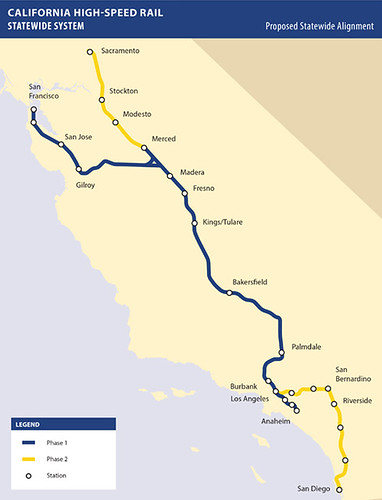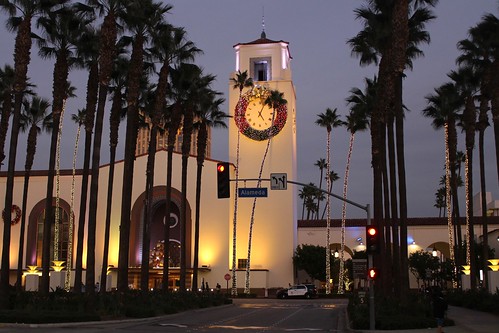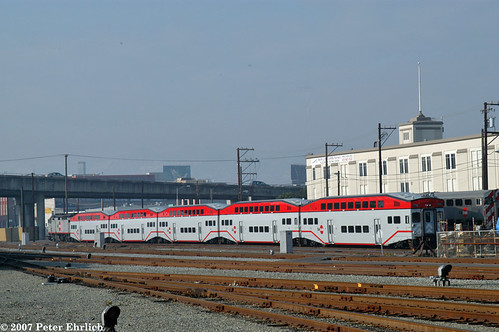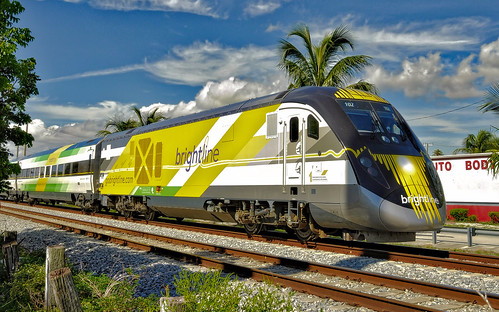High Speed Rail in California to be seriously dialed back
In his State of California speech, new Governor Gavin Newsom pulled back on the plans for a high speed rail line/semi-system in California, because of the high cost and opposition, committing only to going through with the currently underway project in the Central Valley.

Original plan
I'd argue that the California project was somewhat misdirected. But it's possible I am completely wrong.
1. I've learned that "big hairy audacious goals" can be as they say "the hobgoblins of small minds."
It's better to start smaller sometimes, and have proof of concept, and especially important to start where you can be wildly successful. That usually means postponing social justice outcomes to later phases of a project, because in earlier phases, such goals are likely to imperil a project.
Yes, it's a big lift to say start with Los Angeles, but who is going to use HSR in the Central Valley of California?
Tijuana to San Diego to Los Angeles to Santa Barbara, plus LA to Las Vegas, would have been a more productive way to start. It's not that there isn't a lot of demand theoretically for LA to SF, it's just there's a lot of area of not demand between SB and SF.
It's 291 miles from Santa Barbara to San Jose and about 50 miles to San Francisco from San Jose. It's 120 miles to Sacramento from San Jose.
LA Union Station btw is f*ing beautiful. But most of the stations in those bigger cities along the California coast, such as San Diego are also quite attractive.

2. I don't think HSR in Central Valley on its own will have that much in the way of economic impact. The value of train transit is in a network of breadth and depth. Without either, it won't have much effect.
3. Maybe, given the contentious political situation in the US, when the right is against almost anything done by government, especially train service, out of a fear that it verges on communism, it was too big of a lift for California to try such a big project, at least at first.

It would have delayed HSR by ten years or more, but perhaps the thing would have been to focus on making the various existing regional rail passenger programs in Southern California, the San Francisco Bay area, and between Sacramento and the SF Bay much better. For example:
- the ongoing electrification program for Caltrain could have been accelerated, and extended to the Capitol Corridor (Sacramento to San Jose) line.
- Train service to the Transbay Terminal Station in San Francisco could have been accelerated. See Richard Mlynarik website concerning broad civil engineering design problems generally, plus the civil engineering problems with the current station now.
- Double tracking and other improvements could have been implemented for the Metrolink system in Southern California
- other improvements could include integration of Coaster (San Diego County) with some of the Metrolink lines for continuous service rather than hiccup of a connection between the two systems at Oceanside in North San Diego County.
-- "High-Speed Rail Gains Traction in Spain," New York Times
-- "Spain's high speed rail system offers lessons for California," Orange County Register
This was demonstrated by the Obama Administration's failed attempt to move HSR along in large part as an economic development initiative. Many of the states where lines were proposed had Republican Governors, who blocked the proposals.
5. Yes, there are lots of articles about how the US pales in HSR compared to China especially and of course Japan, and yes France or Spain.
-- "Watch Out, Airlines. High Speed Rail Now Rivals Flying/," Bloomberg Businessweek
But now we are being outspanned by Morocco too! A high speed rail service launched last December, funded and designed by French interests.
-- "Will Africa's first high-speed train be a £1.5bn magic bullet for Morocco?," Guardian
(And yes, Moroccan activists argue the money should have been spent on programs for the impoverished.)

6. I don't know what it means exactly but the Brightline privately launched and funded higher speed rail program in Florida has (1) licensed the Virgin Trains brand and will be rebranding; (2) bought the Las Vegas to Southern California's Victorville HSR line, formerly called XPress West, and will also call it Virgin Trains ("High-speed train connecting Las Vegas, Southern California gets new owner," BusinessInsider).
The service currently runs between Miami and Palm Beach with plans for extensions to Orlando and Tampa Bay.
7. Except for vociferous lobbying by airlines, I'd focus HSR on high usage relatively short trip airline corridors (e.g., DC to NYC, NYC to Boston) and build from there.
I think the Texas service proposed between Houston and Dallas, called Texas Central Railway, can be successful, but besides acquiring property, a major problem is the same for the Brightline program--the train stations aren't in the center of the Downtown but on the outskirts, and historically that doesn't work out so well in terms of maximizing the benefits of urbanism, density, and centrality.
However, given the state's conservative bent, the Texas project may well be doomed.
-- "Face the stats: Texas high-speed rail destined for failure [Opinion]," Houston Chronicle
-- "COUNTERPOINT: High-speed rail takes aim at traffic and dangerous highways"
8. There's been a bunch of coverage about decline in passenger rail service quality with Deutsche Bahn and of course the high cost of train travel in the UK, but these countries have dense networks and frequent service, including higher speed rail in Germany. (European style HSR is being developed in the UK, although not without problems.)
Outside of the Northeast Corridor, we don't have anything like the train service in those countries, although the suburban regional rail networks in Chicago, Philadelphia, NY/NJ, and Boston are pretty great, comparatively speaking, with all-day and weekend service.
Labels: high speed rail, railroad passenger services, social change, Transformational Projects Action Planning, transportation planning



12 Comments:
I'd say primary about financing; they took the federal stimulus money and (presumably the $9 billion bond) and building that section -- although it makes no sense.
Yes, they may be waiting for the feds to kick in another 75B to complete the system.
In terms of the government building things, I don't think they have for years -- this is about the ability to manage contractors and why the state is a weak actor in this area.
Very good point about building things. As it was, the government paid for part/motivated the creation of the Transcontinental Railroad, by providing land grants to the firms. But the private sector built it.
... locally can we say streetcar in DC or Arlington?
I think because there is always built in opposition, it is very difficult to do new projects. As much as everyone complains about the Purple Line (and me about failure to fully leverage the opportunity it presents), it's a miracle that it is moving forward!
That being said, Spain and France have been successful in building rail networks and higher speed rail systems.
Not sure what happened there.
Didn't include it as a cite, but an article from El Pais about Spain made the point that one in four AVE stations have minimal use (practically zero). Partly it's because the stations are of a distance from communities, and because they haven't created transit connections to the stations. But still...
Many MARC stations today have minimal usage also (e.g., many on the Camden Line). That's because the historical conditions that created those stops aren't consonant with usage today.
And my point that you need station area plans to make these stations pencil out, but also that they may not pencil out ever, although that doesn't mean for other reasons it still may be important to create the station.
"3. Maybe, given the contentious political situation in the US, when the right is against almost anything done by government, especially train service, out of a fear that it verges on communism, it was too big of a lift for California to try such a big project, at least at first."
I'm going to have to push back against this comment. There are things the government does (war and roads) conservatives love. Spending tax payer money on something that comes across as a boondoggle is a hated thing.
I also think you're ignoring American car culture and its power. I've lived for a summer in Europe and the culture is different. In America we let every idiot who breathes get a drivers license. Our car safety standards are more about the people inside the car, whereas European car safety is about the pedestrians. So a culture or a country with those kind of priorities are going to invest in public transit.
The failure of the streetcar on H Street can also be laid at the feet of American car culture. Imagine what could have been if the city could have eliminated ALL parking along the route?
"Culture is constructed."
And cities, especially center cities, need different mobility policies than suburbs and rural areas.
There is plenty of car culture in Germany. And car manufacturing is a significant element of their economy.
But they recognized that simultaneously they needed to support transit in cities because cities had different conditions.
And there they prioritize environmental elements (also quality of life as an environmental element) which mean they invest in transit.
Even the UK, while it is a major car manufacturer and transit is low on the priority list, major cities have decent enough transit systems, better than the average city in the US. E.g., compare Liverpool to Baltimore.
And again, the UK rail system is criticized vociferously compared to the state of rail in Europe, but it is far more complete and a system than anything we have in the US.
And transit would be better there if it hadn't been "needlessly" privatized in ways that make transit as a system less "legible" and understandable.
But it still works.
Outside of the Northeast Corridor, would you make getting to a place by train your first choice?
In the UK, it's 221 miles to Liverpool from London, and train (if you don't have a car and you buy the ticket in advance with enough time so it isn't astronomical) is a first choice.
https://prospect.org/article/californias-bullet-train-goes-rails
AVE is also very politicized; Zapatero basically rushed through a massive extension without looking at the need.
I'm still reading this as a money issue. They have a decided funded in it looks like about 300M in cap and trade, but that is not enough to fund a system.
In a private email thread, a guy who works in rail passenger planning made the point that the pretty lines on the map are easy, but that to make a real alignment, many many miles of tunneling is required. That's at least $400 million per mile, last I checked.
And yes, without real cap and trade and a supportive federal government, it's very hard to fund.
Even inside the NE corridor train not necessarily my first choice. When visiting NYC we go with the cheap bus (Megabus, Bolt bus, etc) because the train and the bus gets us there in the same amount of time. Since time isn't a saver, price point is a factor. The train is over $100 one way. Last time I was on the bus, RT was something less than $40. A search on Google reveals a RT flight is a smidge over what I'd pay for a one way train trip.
Outside the NE, compare a flight to the train. I'd been avoiding flights as much as possible bc of TSA and my hostility to security theatre. But I want to visit my family in Florida. Do I want to spend nearly 2 days on a train or several hours between entering security lines in DC and picking up the luggage in MCO?
I traveled on the UK's Intercity trains between London and Glasglow. Started off in the morning via slower trains to hook up to the faster train and got to Glasglow just before dark. The train was faster than driving but not as fast as a flight.
Europe's train culture and public transit culture is older and stronger than the American train and transit culture. I already mentioned how not car-centric they are is reflected in the safety standards of European cars. Yes, culture is built, it is also maintained. The people who maintain the train and transit infrastructure are not overwhelmingly true believers, more a little agnostic going through the motions. Example: Jack Evans. Our car culture has true believers, happy clappy fundies, and radical fanatics. With that an expensive train project has no chance.
I'll start off by saying I'm a train enthusiast who also values the relative comfort and space of going by rail vs. bus. Plus, I have the income that I can use to take more premium rail services (e.g., Acela business class) where wifi is being shared among fewer people.
I live near DC (I think the border is about 0.1 miles from my backyard) and occasionally visit my mother in New Jersey. People sometimes ask why I don't drive. Why not? Rail is faster (I can get to Newark to pick up a rental car in, what, 2.5 hours? That's not possible in a motor vehicle), and *I can do work on the train*. Most of my work requires me to be connected to a server, so I can't just talk on the phone or read stuff; I literally need to be connected to a server somewhere in northern Virginia. Maybe buses can do that too, but if I can snag a table, even if sharing with 3 other people, I have room, and I get there pretty quickly. Any bus will not get me to my ultimate destination.
Regarding the US, somehow air travel got a bunch of its needed infrastructure (airports and air traffic control) run by governments. Yes, there are fees airlines pay for the airport, but ATC seems completely Federal (do they pay extra taxes to pay for ATC and security?). Railroads, being surface transportation, need to take care of that maintenance themselves, plus the dispatching. Maybe in the US, despite the seemingly numerous Infrastructure Weeks ove the past couple of years, has just walked away from public support for infrastructure, ignoring the positive feedback and network effects.
I occasionally see rail referred to as 19th century technology. But, the internal combustion engine dated to then, and air flight is only a few years into the 20th century. I fear that there's a complete lack of vision among the people nowadays who rise to the top of political power. We're all satisfied with the investments of 50-100 years ago and are willing to live off of the depreciating assets.
Mari -- I don't disagree with you, really, in terms of trip efficiency. I use Megabus etc. too because it is significantly cheaper, and yes, train doesn't make much sense outside of key areas.
E.g., recently I took Metrolink from Orange County to Los Angeles and back, and then local transit to and from Santa Monica. No way I would have been comfortable driving there.
... I just disagree about the characterization. The US and Europe developed train and public transit networks around the same time.
But (this came out in discussion at a book talk about biking in 2017), the real difference is that the US developed a mass system of automobility much earlier, which led to an abandonment for the most part of railroads and public transit, except for those cities where because of density and other reasons, transit made a lot more sense (the same kinds of conditions present in the cities where transit is prioritized in Europe).
Plus, unlike here, it was not common for women to be able to drive until much later, further dampening demand for automobility, and keeping the market demand for transit up.
... again, to me "culture is constructed." It's not so much about "culture" but how we've constructed our system of mobility.
We prioritize cars in large part because the US isn't just a major car manufacturer but also a major oil producer. Sprawl and automobility help maintain demand for oil, and of course, cars.
Except recently for the North Sea, and of course the Ukraine (I think), Europe hasn't been an oil producer. As a result they haven't had the same political and economic reasons to foster oil use.
Denmark and Netherlands specifically refocused on bicycling in response to the 1973 "oil crisis" which led to a massive upward repricing of oil. There were other reasons too (about the impact of cars on cities and a renewed interest in environmentalism), but perhaps the biggest reasons was that automobile dependence made them completely dependent on oil, and that was too risky of a position from a risk management standpoint.
Of course, public transit use reduces demand for oil too. Even though car manufacturing is an important element of the economy in all of the major European countries.
====
system vs. culture is the thing for me.
WRT:
Our car culture has true believers, happy clappy fundies, and radical fanatics. With that an expensive train project has no chance.
ABSOLUTELY.
So you can't screw up even the least little bit. e.g., DC's streetcar problems are bandied about by streetcar opponents in other cities.
It's why I say people in the profession have a responsibility to succeed wildly because their success or failure has repercussions beyond their community.
Ed -- (1) I like to look at old magazines, and the Assn. of American Railroads used to run "image advertising" in Saturday Evening Post and the like. One of their ads made your point, that they paid taxes on the land their tracks used, while trucks and buses used the roads basically for free. True also for some elements of air travel.
... although for both you and Mari, historically railroads weren't "nice businesspeople," they treated customers, both freight and sometimes passengers, rapaciously, and so people looked at developing a road system as a way to provide competition and to get back at poor treatment.
(2) Yes, RRs are 19th century technology. So are cars. Both have been improved since.
When people use this trope, really what they are talking about is mass transit vs. personalized and individualized mobility.
Instead of making that point, they cast what I would call an "argument to the age of the technology" (a la "argument to the person").
=====
but speaking of systems, for transit to be successful, you need concentration.
e.g., your point about Newark. That's how I feel about taking trips to NYC. I'd rather got out in the core, than have to get to the core from one of the area's airports.
Hi everyone, Are you into trading or just wish to give it a try, please becareful on the platform you choose to invest on and the manager you choose to manage your account because that’s where failure starts from be wise. After reading so much comment i had to give trading tips a try, I have to come to the conclusion that binary options pays massively but the masses has refused to show us the right way to earn That’s why I have to give trading tips the accolades because they have been so helpful to traders . For a free masterclass strategy kindly contact maryshea03@gmail.com for a free masterclass strategy. She'll give you a free tutors on how you can earn and recover your losses in trading for free..
Post a Comment
<< Home